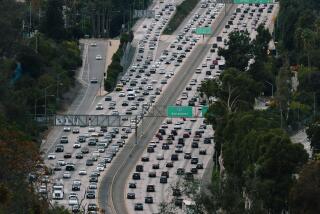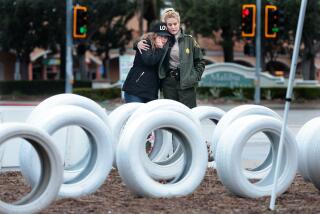Analyst Urges Overhaul of State’s Carpool Lanes
- Share via
SACRAMENTO — It’s a familiar scene: You are frozen in bumper-to-bumper traffic while the carpool lane next to you is nearly empty. The few vehicles that do occupy the special lane whiz by at top speed.
The state should remedy the situation by converting some of that space to toll lanes and to regular traffic lanes in off-hours, says a new report by the legislative analyst.
The nonpartisan office has issued a 24-page document recommending major changes in the management of the state’s 925 miles of carpool lanes to make more effective use of them.
“While . . . the common perception of [high-occupancy-vehicle lanes] as ‘empty’ is not accurate . . . many HOV lanes in California have substantial unused capacity,” the report says.
The document comes as the existence of the carpool lanes is threatened by legislation being proposed by Assemblyman Tom McClintock (R-Northridge). McClintock’s measure, which would eliminate them by opening them to regular traffic, is scheduled to get its first hearing before the Assembly Transportation Committee on Monday.
“If you open up these diamond lanes to all traffic, then everybody gets to work on time,” McClintock said in an interview. “Since the day they were first proposed, HOV lanes made no sense and they make no sense now.”
As California’s major freeways become increasingly congested, the lanes have become more and more controversial. Critics complain that they encourage gridlock by forcing single-driver vehicles to crowd together in the remaining lanes.
New Jersey is the only state so far to convert some carpool space to regular traffic lanes.
Most transportation officials in California--a leader in the use of carpool lanes--see them as an effective tool for relieving traffic congestion and reducing air pollution.
Over the last 25 years, the state has spent $2.3 billion constructing carpool lanes and it plans to double the system in the next 20 years. Seventy percent of the existing lanes are in Southern California; the remaining 30% are in the Bay Area and Sacramento.
In Southern California, their use is restricted to carpoolers 24 hours a day, seven days a week. In Northern California, they are restricted to carpoolers only during peak traffic hours. To use carpool lanes, cars must have two or more occupants, except on some toll roads and the Interstate 80 approach to the San Francisco Bay Bridge, where the requirement is three or more occupants.
Over the years, some motorists have used imaginative tricks to make themselves appear eligible for the special lanes. Some have been caught with dummies in the front passenger seat. Others have carried infant car seats with no infants them. And one pregnant woman insisted that her unborn child qualified her.
In its report, the legislative analyst’s office said Caltrans traffic studies show that, on average, carpool lanes carry “substantially more” people per hour during peak periods than do other traffic lanes.
But the number of vehicles that use the lanes, the report noted, is well below what they were designed to carry. Most of the lanes, the report said, operate at only two-thirds of their capacity. Southern California’s carpool lanes get the least use in San Bernardino County and the heaviest use in Orange County.
While studies have shown that the lanes do encourage carpooling, the analyst said cost savings rather than time savings are the biggest incentive for people to double up in the commute to work.
The report, by analyst Rebecca Long, suggested that one of the most effective ways to increase usage was the creation of more so-called HOT lanes--HOV lanes that allow free access to vehicles with two or more occupants but require driver-only automobiles to pay a toll.
HOT lanes have been in operation along an eight-mile stretch of Interstate 15 in San Diego since 1991. The two lanes, located in the freeway median, operate only during peak hours.
In Southern California, the analyst said some carpool lanes could be open to regular traffic in off-peak hours to increase their capacity. In the past, officials have said they were reluctant to limit the hours of operation because they feared it would be confusing to drivers.
More to Read
Sign up for Essential California
The most important California stories and recommendations in your inbox every morning.
You may occasionally receive promotional content from the Los Angeles Times.










